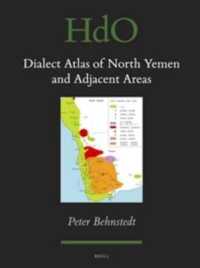- ホーム
- > 洋書
- > 英文書
- > History / World
Full Description
Theology and Society is the most comprehensive study of Islamic intellectual and religious history, focusing on Muslim theology. With its emphasis on the eighth and ninth centuries CE, it remains the most detailed prosopographical study of the early phase of the formation of Islam. Originally published in German between 1991 and 1995, Theology and Society is a monument of scholarship and a unique scholarly enterprise which has stood the test of time as an unparalleled reference work.
Contents
2.2 Basra
2.2.1 The 'heretics'
2.2.1.1 Bashshār b. Burd
2.2.1.2 Ṣāliḥ b. ʿAbd al-Quddūs
2.2.1.3 The Sumaniyya
2.2.1.4 Ibn al-Muqaffaʿ
2.2.1.4.1 A text against Islam
2.2.1.4.2 The parody of the Quran
2.2.1.5 The environment. 'Natural philosophers'
2.2.2 Ḥasan al-Baṣrī and his spiritual successors
2.2.2.1 The Qadariyya
2.2.2.1.1 Qadarite ideas in hadith
2.2.2.1.2 Qadarite traditionists
2.2.2.1.2.1 The generation following Ḥasan al-Baṣrī
2.2.2.1.2.2 The middle generation
2.2.2.1.2.3 Pupils of Saʿīd b. Abī ʿArūba
2.2.2.1.2.4 Other Qadarites in the second half of the second century
2.2.2.1.3 The Uswārīs
2.2.2.1.4 Qadarites among the Basran grammarians
2.2.2.2 Qadariyya and asceticism
2.2.2.2.1 Ḥasan al-Baṣrī's younger contemporaries
2.2.2.2.2 The following generation
2.2.2.2.2.1 The importance of ʿAbbādān
2.2.2.2.3 Theological and juristic special opinions within the circle of Basran ascetics
2.2.2.2.3.1 The Bakriyya
2.2.2.2.4 Asceticism and rationality
2.2.3 The jurists
2.2.3.1 The case of Iyās b. Muʿāwiya
2.2.3.2 Early theoretical texts
2.2.3.3 Experts and jurisconsults
2.2.3.4 Kullu mujtahid muṣīb
2.2.4 Murjiʾites in Basra. The 'Ghaylāniyya'
2.2.4.1 Faḍl al-Raqāshī
2.2.4.2 Abū Shamir and his school
2.2.4.3 'Jahmites'
2.2.5 The Ibāḍiyya
2.2.5.1 The case of ʿAbdallāh b. Ibāḍ
2.2.5.2 The development of the Basran community
2.2.5.3 The question of qadar
2.2.5.4 The quarrel over the anthropomorphisms
2.2.5.5 Further controversial issues
2.2.5.6 The environment
2.2.5.7 The relation between sin and faith
2.2.5.8 Puritanism and scrupulousness
2.2.6 The early Muʿtazila
2.2.6.1 Wāṣil b. ʿAṭāʾ
2.2.6.1.1 The chronology of his life. His origins and profession
2.2.6.1.2 Wāṣil the khaṭīb. His appearance before ʿAbdallāh b. ʿUmar b. ʿAbd al-ʿAzīz
2.2.6.1.3 Wāṣil's speech defect
2.2.6.1.4 Wāṣil's relations with the ʿAlids in Medina
2.2.6.1.5 The image of Wāṣil's personality
2.2.6.1.6 Wāṣil's relationship with ʿAmr b. ʿUbayd and Ḥasan al-Baṣrī
2.2.6.1.7 The doctrine of the intermediate state
2.2.6.1.7.1 Sin and penitence
2.2.6.1.7.2 Wāṣil's relationship with Khārijites and Murjiʾites
2.2.6.1.8 Wāṣil's political views
2.2.6.1.9 Further points of doctrine
2.2.6.1.9.1 Epistemological issues
2.2.6.2 ʿAmr b. ʿUbayd
2.2.6.2.1 Biographical data
2.2.6.2.2 Political decisions
2.2.6.2.2.1 The relationship with Manṣūr
2.2.6.2.3 The image of ʿAmr's personality
2.2.6.2.4 His relationship with Ḥasan al-Baṣrī
2.2.6.2.4.1 ʿAmr as an exegete
2.2.6.2.5 ʿAmr as a legal scholar
2.2.6.2.6 ʿAmr as a traditionist
2.2.6.2.7 Theology and politics
2.2.6.3 The pupil generation
2.2.6.3.1 The circle around Wāṣil
2.2.6.3.1.1 The duʿāt
2.2.6.3.1.2 Wāṣil's other pupils
2.2.6.3.2 The circle around ʿAmr b. ʿUbayd
2.2.6.3.2.1 Jurists and traditionists
2.2.6.3.2.2 The 'Muʿtazilites' of the uprising of AH 145
2.2.6.4 The origin of the name Muʿtazila
2.2.7 The traditionist reaction
2.2.7.1 Opposition against ʿAmr b. ʿUbayd
2.2.7.1.1 Ayyūb al-Sakhtiyānī
2.2.7.1.2 Yūnus b. ʿUbayd
2.2.7.1.3 ʿAbdallāh b. ʿAwn
2.2.7.1.4 Sulaymān al-Taymī
2.2.7.1.5 Abū ʿAmr Ibn al-ʿAlāʾ
2.2.7.2 The next generation
2.2.8 The Muʿtazila in Basra during the second half of the second century
2.2.8.1 Ṣafwān al-Anṣārī
2.2.8.1.1 The image of the early Muʿtazila in Ṣafwān's qaṣīda
2.2.8.2 The principle of amr bil-maʿrūf wal-nahy ʿan al-munkar
2.2.8.2.1 The case of Muḥammad b. Munādhir
2.2.8.3 The position of the Muʿtazila in Basra after 145
2.2.8.4 The development of theology and law
2.2.8.4.1 Al-Aṣamm
2.2.8.4.1.1 Aṣamm's 'ontology'
2.2.8.4.1.2 Aṣamm's Quranic commentary
2.2.8.4.1.3 The consensus of Muslims
2.2.8.4.1.3.1 Consensus and political theory
2.2.8.4.1.4 Aṣamm the lawyer
2.2.8.4.2 Ibn ʿUlayya
2.2.8.4.3 Further Basran Muʿtazilites
2.2.9 Basran Shīʿites
2.3 Wāsiṭ
2.4 The Jazira
2.4.1 Ḥarrān
2.4.1.1 The Ṣābians
2.4.1.2 Ḥarrān and Islamic theology
2.4.2 Diyār Rabīʿa
2.4.2.1 The Khārijites
2.4.2.2 Mosul
2.4.2.3 Nisibis
2.4.3 Raqqa
2.4.3.1 Sulaymān al-Raqqī
2.4.3.2 Extreme Shīʿites
3. Iran
3.0 General preliminary remarks
3.1 Eastern Iran
3.1.1 Jahm b. Ṣafwān
3.1.1.1 The connection between Jahm and the Jahmiyya
3.1.2 The cities
3.1.2.1 Balkh
3.1.2.1.1 Quranic exegesis
3.1.2.1.1.1 Muqātil b. Ḥayyān
3.1.2.1.1.2 Muqātil b. Sulaymān
3.1.2.1.1.2.1 Muqātil's theological views
3.1.2.1.2 ʿUmar b. Ṣubḥ and the rafʿ al-yadayn
3.1.2.1.3 Murjiʾites and Ḥanafites
3.1.2.1.4 The beginnings of eastern Iranian mysticism
3.1.2.2 Marv
3.1.2.3 Tirmidh
3.1.2.4 Samarqand
3.1.2.5 Herat
3.1.3 Sīstān
3.1.3.1 The Khārijites
3.1.3.1.1 Ḥamza b. Ādharak's uprising
3.1.3.2 Non-Khārijite groups
3.1.4 The western part of the province of Khorasan
3.1.4.1 Khorasanian Khārijites
3.1.4.1.1 The Bayhasiyya
3.1.4.1.1.1 Yamān b. Riʾāb
3.1.4.1.2 The Ibāḍiyya
3.1.4.2 Nishapur
3.2 Central and southern Iran
3.2.1 The Khārijites
3.2.1.1 Yazīd b. Unaysa and the uprising of Abū ʿĪsā al-Iṣfahānī
3.2.1.2 Later Khārijites
3.2.2 ʿAbdallāh b. Muʿāwiya
3.2.3 The cities
3.2.3.1 Isfahan
3.2.3.2 Qom
3.2.3.3 Hamadan
3.2.3.4 Rayy
4. The Arabian Peninsula
4.1 The Hijaz
4.1.1 Mecca
4.1.1.1 The Qadarites
4.1.1.2 The Khārijites
4.1.1.2.1 The Ibāḍites
4.1.1.3 The Murjiʾites
4.1.1.4 The Shīʿites
4.1.2 Medina
4.1.2.1 The Khārijites
4.1.2.2 The Murjiʾa
4.1.2.3 The Qadarites
4.1.2.3.1 Al-Nafs al-zakiyya's uprising
4.1.2.3.2 Later developments. Resistance against the Qadariyya
4.1.2.4 The Jahmiyya
4.2 Southern Arabia
4.2.1 Yemen
4.2.1.1 The Qadarites
4.1.2.1 Other trends
4.2.2 Oman and Ḥaḍramawt
5. Egypt
5.0 General preliminary remarks
5.1 Shīʿite tendencies
5.2 Counter-trends. The Ibāḍiyya
5.3 Implicit theology. Hadith
5.4 Explicit theology. Kalām
5.4.1 Theologians of uncertain affiliation







